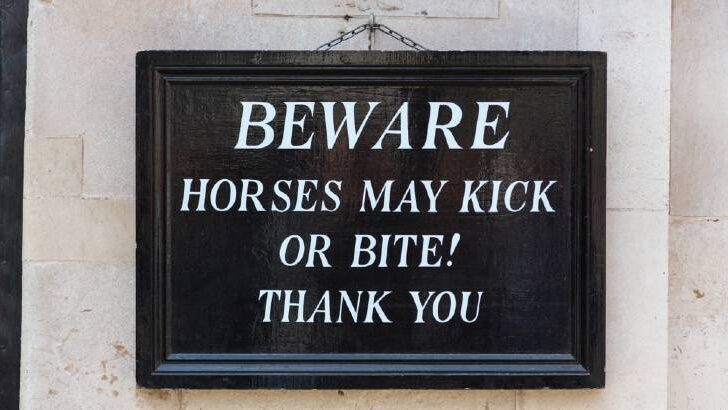Affiliate Disclaimer
As an Amazon Associate I earn from qualifying purchases. It helps me keep the website going. Thank you for your support.
Horses are very social animals who develop strong bonds with other horses, animals, and humans. Horses naturally seek leadership and establish and maintain their rank in herd pecking orders. Disrespect happens when a horse does not see humans as their leader. But what are the signs of a disrespectful horse, and what can you do about it?
The signs of a disrespectful horse fall into three main categories: space invasion, aggression, and failure to respond to pressure. There are many examples of common disrespectful behaviors, like pushing, biting, or bucking. This is usually caused by a lack of training or because the horse has become dominant over their handler. However, it is important to rule out any health issues that cause behavior that looks like disrespect.
Horses are large and heavy animals. If they are not trained to respect our boundaries, handling them becomes extremely dangerous. Read on to learn how to spot and stop disrespectful behavior.
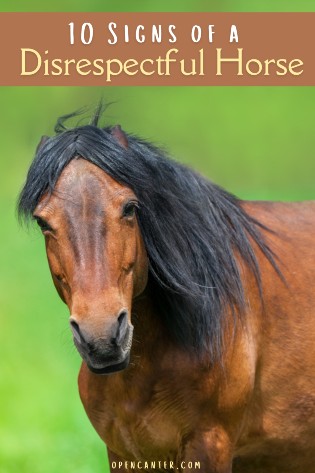
Top 10 Signs of a Disrespectful Horse
Here are the top ten signs of a disrespectful horse in each of the three main categories:
Space invasion:
Sign 1) Invading personal space: this includes the horse pushing you, leaning on you, crowding you, or simply standing too close.
Sign 2) Barging or pushing when being led: these horses barge past you in gateways and tow you along when they are being led.
Sign 3) Nipping or biting: a very dangerous disrespectful behavior! Horses can nip or bite to show their displeasure with your command; or because they are expecting treats. They can also bite as a way of forcing you to move out of their way.
Aggression:
Sign 4) Pinning ears back: when a horse pins its ears back, it is a clear signal for you to move out of their space. Disrespectful horses will learn over time that pinning ears back makes you move away.
Sign 5) Turning their hindquarters towards you or kicking out: a disrespectful behavior that horses can use to prevent you from approaching.
Sign 6) Aggression around food time: all horses love food and most usually get a little excited when it is feed time. Disrespectful horses can become aggressive at feed time, charging at you or knocking you out of the way.
Sign 7) Striking: this occurs when the horse strikes out at you with their front legs. This can happen when you approach the horse or while you are trying to lead them.
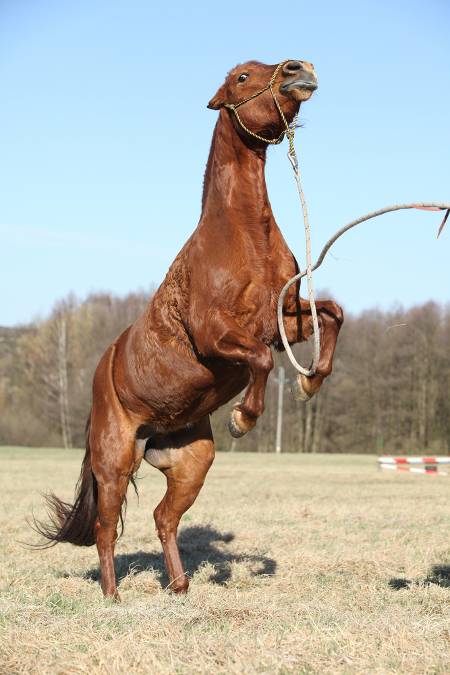
Failure to Respond to Pressure or Cues:
Sign 8) Ignoring cues or commands: a disrespectful horse might consistently ignore your cues or commands. Examples include not moving off or not halting under the saddle when asked.
Sign 9) Dragging on the lead rope: These horses do not walk at your pace when being led, but rather drag along behind you. This can escalate to the horse simply not moving at all!
Sign 10) Disobedience under saddle: There are a number of disrespectful behaviors that can be observed when horses are being ridden. These include rearing, bucking or pig-rooting, running backward, or resisting or evading cues.
What Makes a Horse Become Disrespectful?
There are a number of things that can cause a horse to become disrespectful. Here are four possible causes:
1) Lack of Consistent Training
The most common cause is simply a lack of correct or consistent training. Lack of clear leadership is another factor that creates disrespect. Your horse will simply make their own decisions and use dominant behavior to establish themselves as the leader.
2) Being in Pain
Horses can also exhibit some signs of disrespect due to pain. For example, a horse with a sore back might try to bite when you put the saddle on or do up the girth. In these cases, once the cause of the pain is gone, the behavior usually goes away too.
However, sometimes there is a very fine line between pain and disrespect. The same horse might not actually have a sore back. Instead, they might be trying to avoid being ridden by stopping you from putting the saddle on. Horses are extremely clever!
This is why it is important to get a health check done by a veterinarian before starting any training. They will be able to find any issues that are causing your horse pain. It is also recommended to get your saddle, bit, and other equipment checked to make sure it fits correctly.
3) Fear and Insecurity
Fear or insecurity can also be linked to disrespectful behavior. For example, the horse that barges past their handler while walking through gateways may have fears about narrow spaces. The same can be said for horses that have been mistreated. For these horses, the behavior is a defense mechanism, not a sign of disrespect.
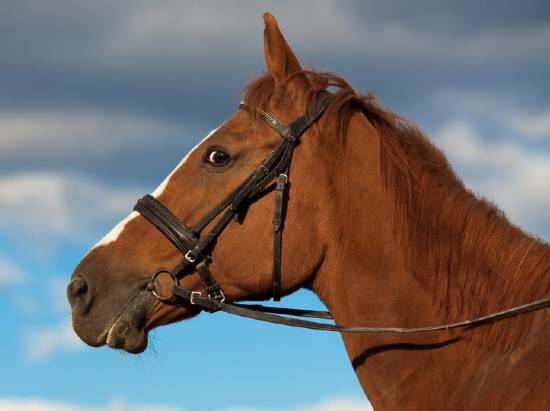
4) Excess Energy
A horse can also exhibit signs of disrespectful behavior when they have too much energy. Feeds that are high in sugar or carbohydrates can cause horses to become ‘fizzy’ or excitable. This can lead to the horse becoming pushy, spooking, restless, and generally difficult to handle or ride.
Using Groundwork to Deal With the Signs of a Disrespectful Horse
Groundwork refers to specific exercises that you complete with your horse on foot with a halter and lead rope. These exercises bring everything back to basics to help strengthen your relationship with your horse. Some groundwork exercises even mimic things you would ask for when riding.
There are a few important pieces of equipment to have before you start groundwork. It is recommended to use a rope halter and a long lead rope. A rope halter allows the horse to feel pressure more clearly than other halter designs. A longer lead rope is necessary as some of the exercises require you to be further away from your horse.
You will also need a dressage or lunge whip. This is used as a tool to ask your horse to move and to preserve your personal space. It should never be used to hit the horse. Think of the whip as an extension of your arm.
Lastly, choose a level area to do your groundwork. It can help to use an enclosed area, like a round yard. However, any area will work so long as it is level and free from hazards. Make sure you wear appropriate clothes, and a helmet and boots, when doing groundwork.
Tips for Managing Horses That Invade Your Space
Start by leading your horse normally. Ask them to stop and the moment they enter your space, turn and ask them to step back. You can do this by turning to face the horse and shaking the lead from side to side. Stand tall and make eye contact.
The moment your horse steps back out of your space, stop the shaking and soften your body back to normal. This communicates to your horse that you do not appreciate them invading your space. It also sets the tone for where your space bubble is.
Continue repeating this until your horse consistently stops outside of your space bubble. A variation of this is to remain standing to test if your horse creeps back into your space. If they do, immediately ask them to back out as above.
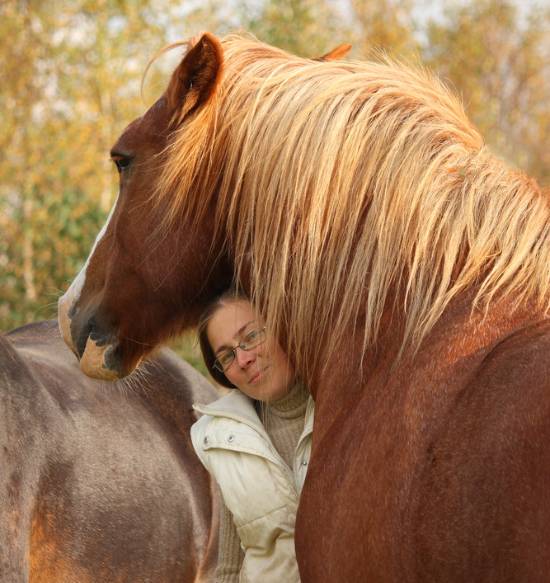
Tips For Horses That Don’t Walk Forward When Asked
Practice leading your horse and make sure you carry a whip in your left hand. Ask your horse to move forwards using pressure from the lead rope. If they do not respond, immediately back up your request with a tap from the whip on the hindquarters of the horse. As soon as they move, remove pressure and reward.
Your horse will learn to move from the pressure on the halter, to avoid being tapped with the whip. This technique can also be used for horses that drag behind when being led. If your horse starts to slow down, apply pressure on the lead to ask them to speed up. If they do not respond, back up your request with the whip.
Tips For Horses That Pull Ahead When Being Led
These horses will benefit from the space invasion exercises above. Additionally, simply practice leading them. Change direction and speed often, to really get your horse focusing on you. Your horse should match your speed and direction and remain at your side at all times. As soon as they start to rush, turn and ask them to back up.
Tips For Horses That Are Aggressive at Feed Time
To start with, work on the space invasion exercises above outside of feed time. Master these and you can incorporate a feed bucket into your sessions. Your aim is to teach your horse that they are not permitted to eat until you have put the bucket down and moved away.
To do this, start by approaching an empty bucket that is on the ground. If your horse makes any attempt to push past you, immediately ask them to back up or send them out on a circle at a trot.
Once you can approach the bucket calmly, start to carry the bucket while leading your horse. If they try to push or bite, ask them to back out of your space or circle. Start to place the bucket down and step away, allowing your horse to investigate the bucket.
The last step is practicing the same steps at feed time. It can help to carry a whip to help preserve your space bubble. If your horse charges in, use your whip and body language to ask them to move back and stay out of your space.
Tips For Horses That Nip or Bite
Work on exercises that establish your space and place special emphasis on preserving this. Your horse cannot bite you if they are not close enough to do so. This will teach your horse to respect you, your space, and your leadership.
Every time your horse tries to bite, promptly ask them to back up out of your space or circle. Your horse must keep moving until you ask them to stop.
For horses that pin their ears back, turn their hindquarters to you, or strike
Once again, work on exercises that get your horse to respect you and your personal space. You need to establish yourself as the leader. You can do this by making your horse move its feet at your request. They must not stop until you ask them to.
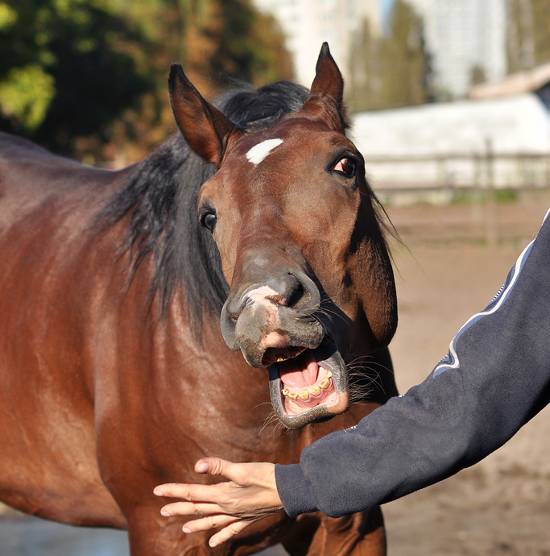
Tips For Horses That Barge Through Gateways
Firstly, make sure you have worked on the exercises above for horses that pull. If this does not resolve the issue, work on leading your horse through narrow spaces. You can use two barrels set apart. Gradually bring the barrels closer and get your horse comfortable that you are their leader and will keep them safe.
Riding Exercises To Deal With the Signs of a Disrespectful Horse
If your horse is being disrespectful under saddle, first make sure you earn their respect on the ground first. In some cases, groundwork exercises can fix the issues you are having when riding.
To start with, use groundwork to teach your horse an ‘emergency stop’. Some trainers also call this technique ‘bending to a stop’. This is where the rider uses one rein to bend the horse’s nose around to their foot. In this position, the horse can only keep circling or come to a stop.
Teaching this can be an effective safety measure to help the rider maintain control when the horse is misbehaving. The rider can ask the horse for an emergency stop if they feel unseated by a buck. It is important to teach the horse the technique on the ground before trying it under saddle.
Start by bending your horse’s head around towards their ribcage. They may or may not move their feet in a small circle. As soon as your horse stops, praise them and release the pressure. Repeat this on both sides until your horse understands that this type of bending means they need to stop.
Horses That Pig Root or Buck
Most horses don’t buck under saddle without a reason – like excess energy or pain. However, once a horse has learned that bucking is an effective way to remove their rider, it can become a habit.
Start doing some groundwork exercises before you mount up. These are not designed to tire the horse out, but rather get them thinking. Use exercises that incorporate frequent stops, starts, and changes of direction.
Ride your horse regularly and keep to a routine. To start with, avoid situations that your horse is most likely to buck in. Most horses find it easier to buck in canter or in the transition from trot to canter.
Stick to walk and trot for your first few sessions. Keep your horse focused with frequent changes of direction and pace. Do not let them have the opportunity to think about bucking. (source)
Horses That Rear
Rearing horses have an added layer of danger as if the rider is not balanced, they can fall over backward. If you are not confident it is best to seek professional help.
Horses who rear are not respecting your aids to move forwards. Use groundwork exercises to reinforce your forward cues. When under saddle, use similar exercises to those suggested for the sluggish horse.
If you feel like your horse is about to rear, use your legs to move them forward. You can also ask for an emergency stop – your horse cannot rear from this position. Immediately after, get your horse going forwards and put them to work. (source)
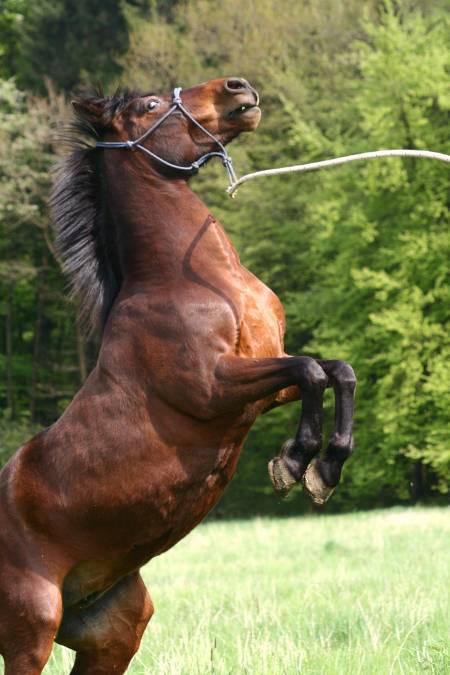
Horses That Are Sluggish or Who Refuse to go Forward
You need to sharpen your horse’s response to your leg when asking them to move forwards. Remember – horses can feel a fly land on them! You should not need to kick to get a horse going – a gentle squeeze is enough!
Start on the ground, reinforcing your forward cue when leading your horse. It is also good to work on this when lunging your horse.
When riding, make sure you carry a whip when starting this exercise. Ask your horse to move off with a gentle squeeze. If they do not move, immediately follow this with a flap of your legs and a tap with the whip.
As soon as you get forward movement, reward the horse. Repeat this exercise until your horse moves forward from the gentle squeeze.
Horses That Are Hard to Stop
Start with groundwork exercises that focus on getting your horse to stop from the lightest pressure possible. You can incorporate a verbal cue, like ‘whoa’ or ‘halt’ to help cue your horse.
Exercises include practicing leading your horse and asking them to move backward. You can do these exercises in both a halter and a bridle.
Once you progress to ridden work, focus on improving the halt in a walk only at first. Use your body as an aid, by sinking your weight down into the saddle and squeezing the reins.
Keep this pressure consistent until your horse stops. The moment they do, release all pressure and reward your horse. You can train your horse to stop based only on your weight sinking down in the saddle.
Top Five Tips For Successful Training
There are things you can do if you think you have spotted signs that your horse is being disrespectful. Here are some top tips to help you achieve your training goals!
Tip 1) Hone your timing to perfection:
The release of pressure is what teaches the horse. For example, you are training your horse to step forward from pressure on the halter. You need to release that pressure as soon as your horse takes even the tiniest step forward.
If you don’t, the horse will try other options to find the right response to release the pressure. This can result in accidentally training the horse to do things like tossing their head. This makes you lose grip on the lead rope causing a release of pressure.
Tip 2) Be very clear and consistent:
Your horse will struggle to understand what you want if your expectations are constantly changing. If you want your horse to always stop half a meter behind you, then make sure you reinforce that. If you allow them to occasionally bump their nose into you, you will never set a clear boundary.
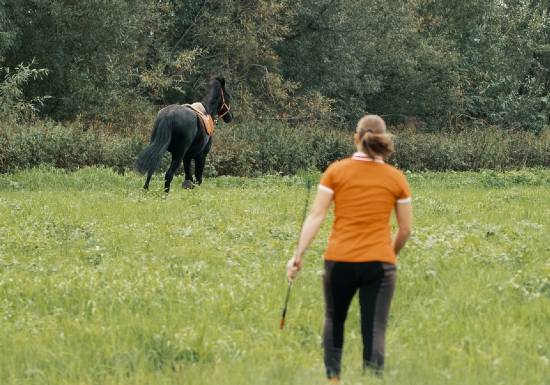
Tip 3) Use ‘horse body language’:
Obviously, you can’t imitate behaviors like biting, pinning your ears back, or kicking. However, you can employ some horse body language techniques in your training. When asking your horse to move out of your space, make direct eye contact and stand tall. This mimics the confident and dominant behavior of alpha horses.
Tip 4) Seek professional help:
Even if you are an experienced horse person, it can be useful to seek help. This could be getting a trainer to work with your horse or taking lessons to learn new training techniques yourself. Sometimes a slightly different approach can be the key to resolving your horse’s dominant behavior.
Tip 5) Invest in the right equipment:
make sure your equipment is safe and fit for purpose. Even if you are doing groundwork, it is a good idea to wear a helmet and gloves. Wearing boots is a must, and if you are working with a horse that bites then long sleeves can help protect your skin. Also, make sure your horse’s tack is suitable, fits well, and is safe. For example, using a rope halter will make applying and releasing pressure easier, making your training easier.
Finding Out The True Cause – Disrespect or Something More?
It can sometimes be hard to tell if a horse is being disrespectful or if their behavior indicates signs of something else. Before you make a plan to resolve your horse’s behavior, you need to identify the true cause. This will allow you to develop a targeted strategy that sets you and your horse up for success.
It is recommended to get a health check by a veterinarian before commencing training. They will examine your horse for signs of pain or lameness. If any issues are found, they will be able to recommend treatments to resolve the problem.
It is also recommended to evaluate your riding equipment. If your saddle, bit, or any other item hurts or irritates your horse, they may act out. Book an appointment with a saddle fitter or bit fitter to help you in this area.
If your horse seems overly excitable, getting a nutritionist to evaluate their diet can help. They will be able to help you reduce the amount of energy your horse gets in their feed. Additionally, they can recommend some calming supplements that may help your horse become more manageable.
Because horses cannot talk, they can only speak to us through their actions. Even though their behavior is disrespectful, they might simply be trying to tell us something. By doing a full check of your horse and their equipment, you can rule out any of these issues.
Final Thoughts
There are many signs of a disrespectful horse, and each point to a different cause and solution. Disrespectful behavior should not be tolerated as it presents a serious injury risk to you and your horse. Ensuring your horse receives the right training and health care will help prevent disrespectful behavior from developing. Additionally, making sure you are confident in your horse handling skills will help your horse see you as their leader – not the other way around!

